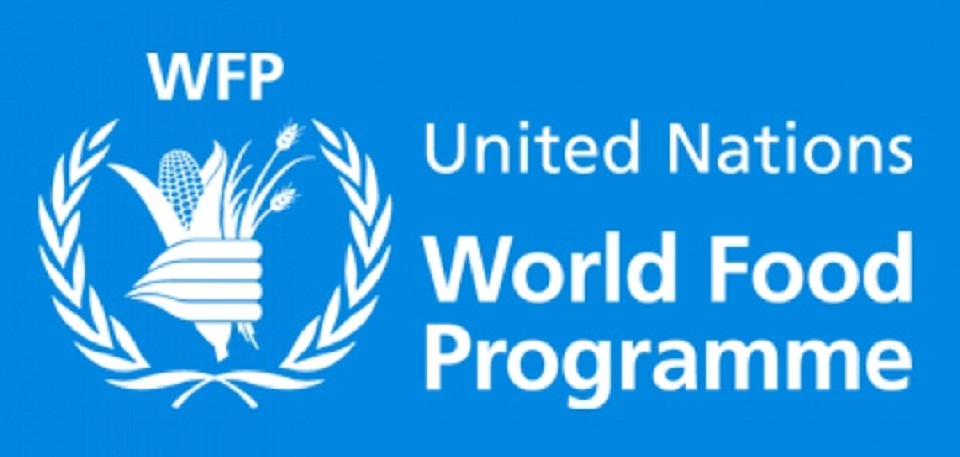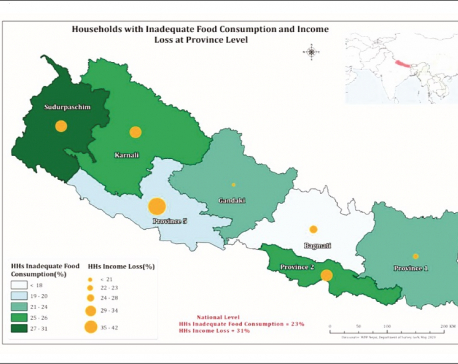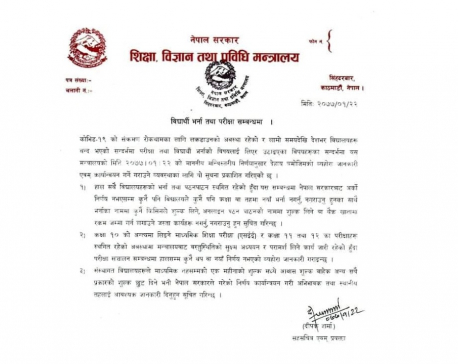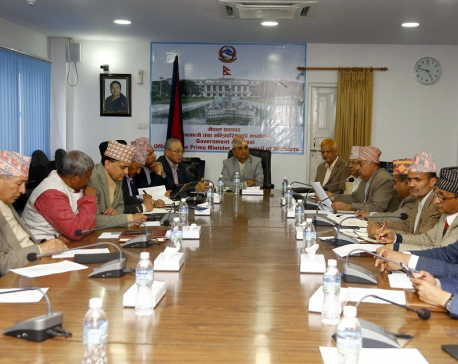
OR
4.6 million Nepalis are food-insecure, and 10% have severe need
Published On: April 16, 2020 09:28 AM NPT By: SHREE RAM SUBEDI

KATHMANDU, April 16: As the country is in the fourth week of lockdown to contain the spread of novel coronavirus (Covid 19), with two more weeks extension from Tuesday, a UN agency has warned that a widespread food insecurity is likely.
"Significant reductions in the harvest of wheat and winter crops, and in the planting of rice and summer crops could have serious implications for food security in the price and availability issues, leading to widespread food insecurity," a WFP Nepal Office report entitled "Nepal COVID-19:Food Security & Vulnerability Update" warns.
Though food security in Nepal has improved in recent years, 4.6 million people are still food-insecure, with 20 percent of households mildly food-insecure, 22 percent moderately food-insecure, and 10 percent severely food-insecure, according the 2016 Nepal Demographic and Health Survey. Overall, households in rural areas —where food prices tend to be higher—are more likely to be food-insecure than people living in urban areas, according to the survey.
The UN agency in Nepal has expressed concern that restriction of movement of people could impact crop harvest.
"This period marks the start of the wheat harvest, but restrictions on movement of people, combined with an absence or shortage of daily agricultural wage labor from other regions could impact the final harvest, " the WFP report, which was shared only with limited donors and government ministries, said.
With lockdown imposed in India from March 25, over 120 thousand low income migrant Nepalis workers from India have returned home, especially in the mid and far-west, which is also a home to Nepal’s most vulnerable and food insecure populations.
Around 62 per cent of workers in Nepal are employed in the informal sector, with little recourse to social insurance. "If present trends continue, food security is expected to increase among: households engaged in informal labor, precarious labor, service sector and daily wage work, as well as households with return migrants and income losses." the report said.
The impact on food import due to the lockdown, as small disturbances in the inflow of food commodities, invite a ripple effect on food security in Nepal. Official data from mid-July 2019 to mid-February 2020 shows that Nepal imported an average of 62,600 metric tons of rice and 49,000 metric tons of maize per month. On an average, Nepal imports 600 thousands metric tons of rice and 100 thousands metric tons of wheat annually, according to the Ministry of Agriculture and Livestock Development(MoALD). Besides, Nepal imports 400 thousand metric tons of maize a year, mostly to feed poultry.
MoALD spokesperson, Dr Hari Bahadur KC, confides that food security is a concern in case the import is impacted. However, he claims that there is no likelihood that the agriculture crop production would decrease this year. "The winter crops are ready to be harvested and the summer crops are less likely to be affected."
The four pillars of food security includes, KC said, availability, access, utilization and stabilization. Among them, the transportation constraint is posing problems. He also highlights the need for consumption of buckwheat and millet in the far-west instead of rice to avoid food insecurity."The production and consumption of these traditional crops would ease the food insecurity status in these regions," he said.
Nepal's constitution of 2015 has also included the Right to Food as a fundamental rights for its citizens while the Right to Food and Food Sovereignty Act (2018) has detailed various measures to be taken to ensure the Right to Food.
You May Like This

Food insecurity increased to 23 percent; Karnali most vulnerable
KATHMANDU, June 17: COVID-19 has increased food insecurity by 8 percentage points, a national survey showed. A household-level survey conducted... Read More...

Schools asked not to open admissions until further notice, charging for online classes prohibited
KATHMANDU, May 4: The Ministry of Education, Science and Technology has instructed the educational institutions not to announce admissions for... Read More...

12 crucial decisions taken by High Level Govt Committee to contain COVID-19
12 crucial decisions taken by High Level Govt Committee to contain COVID-19 ... Read More...

Just In
- Indians vote in the first phase of the world’s largest election as Modi seeks a third term
- Kushal Dixit selected for London Marathon
- Nepal faces Hong Kong today for ACC Emerging Teams Asia Cup
- 286 new industries registered in Nepal in first nine months of current FY, attracting Rs 165 billion investment
- UML's National Convention Representatives Council meeting today
- Gandaki Province CM assigns ministerial portfolios to Hari Bahadur Chuman and Deepak Manange
- 352 climbers obtain permits to ascend Mount Everest this season
- 16 candidates shortlisted for CEO position at Nepal Tourism Board






_20220508065243.jpg)











Leave A Comment